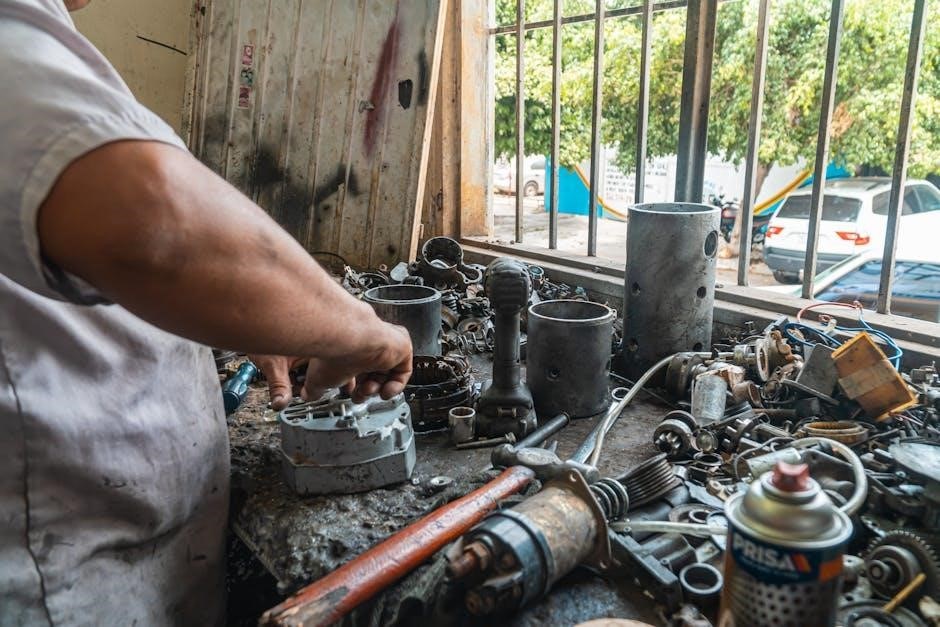The 2013 VW Jetta fuse box diagram is a crucial guide for owners, providing a clear map of fuse locations and functions, available in pdf format for easy access and reference, helping to simplify troubleshooting and repair processes effectively always․
Overview of the Fuse Box Diagram
The 2013 VW Jetta fuse box diagram provides a comprehensive overview of the vehicle’s electrical system, including the location and function of each fuse and relay․ This diagram is essential for troubleshooting and repairing electrical issues, as it allows owners to identify the source of the problem and take corrective action․ The diagram is typically divided into sections, with each section corresponding to a specific area of the vehicle, such as the engine compartment or interior․ By consulting the fuse box diagram, owners can determine which fuse or relay is responsible for a particular electrical component, and replace it if necessary․ The diagram is usually available in pdf format, making it easy to access and print out for reference․ Overall, the 2013 VW Jetta fuse box diagram is a valuable resource for anyone who wants to understand and maintain their vehicle’s electrical system․ It is a complex system, but with the help of the diagram, owners can navigate it with ease and confidence․ The diagram is also useful for mechanics and technicians who need to diagnose and repair electrical problems in the vehicle․

Location of the Fuse Boxes
The 2013 VW Jetta has fuse boxes located in the engine compartment and passenger compartment, easily accessible for maintenance and repair, with clear labels and diagrams available in the pdf manual for reference always․
Engine Compartment Fuse Box
The engine compartment fuse box in the 2013 VW Jetta is located on the driver’s side of the engine compartment and contains a variety of fuses that control different systems in the vehicle․
The fuse box is held in place by a number of screws and clips, and can be removed for access to the fuses and relays inside․
A diagram of the engine compartment fuse box is available in the pdf manual, which shows the location and function of each fuse and relay․
This diagram is essential for identifying and replacing blown fuses, as well as for troubleshooting electrical problems in the vehicle․
The engine compartment fuse box contains fuses for systems such as the engine control unit, radiator fan, and lambda probe heater, among others․
Each fuse has a specific amp rating and is designed to protect the corresponding system from electrical overload or short circuits․
By consulting the diagram in the pdf manual, owners can quickly and easily identify the location and function of each fuse in the engine compartment fuse box․
This can save time and frustration when working on the vehicle, and can help to ensure that electrical problems are diagnosed and repaired correctly․
Overall, the engine compartment fuse box is an important component of the 2013 VW Jetta’s electrical system, and the diagram in the pdf manual is a valuable resource for owners and technicians alike․
The diagram provides a clear and concise guide to the location and function of each fuse and relay, making it easier to work on the vehicle and keep it in good running condition․

Understanding the Fuse Box Diagram
The 2013 VW Jetta fuse box diagram is a complex guide requiring careful study and interpretation to understand fuse locations and functions correctly always using pdf diagrams․
Reading the Diagram
To read the 2013 VW Jetta fuse box diagram, owners should start by identifying the different sections and labels, using the pdf guide to locate specific fuses and understand their corresponding functions and ampere ratings․
The diagram is typically divided into several parts, including the engine compartment fuse box and the interior fuse box, each with its own set of fuses and relays, requiring careful examination to avoid confusion․
By referring to the diagram, owners can determine which fuse corresponds to a particular system or component, such as the headlights or windshield wipers, and take necessary steps to repair or replace the faulty fuse, using the diagram as a reference guide․
It is essential to note that the fuse box diagram may vary depending on the vehicle’s trim level and options, so owners should consult the correct diagram for their specific vehicle, using the pdf guide to ensure accuracy․

Overall, reading the 2013 VW Jetta fuse box diagram requires attention to detail and a basic understanding of electrical systems, but with the right guidance, owners can navigate the diagram with confidence and perform necessary repairs and maintenance tasks, using the pdf diagram as a trusted resource․
The diagram is a valuable tool for any owner, providing a clear and concise guide to the vehicle’s electrical system, and helping to simplify troubleshooting and repair processes, making it an indispensable resource for anyone working on their 2013 VW Jetta․

Importance of the Fuse Box Diagram
The 2013 VW Jetta fuse box diagram is a crucial component of the vehicle’s maintenance and repair process, providing a clear and concise guide to the electrical system, and helping owners to identify and resolve issues quickly and efficiently․
Having access to the fuse box diagram is essential for any owner, as it allows them to troubleshoot problems and perform repairs with confidence, saving time and money in the long run, and reducing the risk of further damage to the vehicle․
The diagram is also an invaluable resource for professional mechanics, providing a detailed and accurate guide to the vehicle’s electrical system, and helping them to diagnose and repair complex problems, using the pdf guide to inform their work․
In addition, the fuse box diagram is an important safety tool, helping owners to identify potential electrical hazards and take steps to prevent them, reducing the risk of accidents and injuries, and ensuring the safe operation of the vehicle․
Overall, the 2013 VW Jetta fuse box diagram is a vital resource for anyone working on the vehicle, providing a clear and concise guide to the electrical system, and helping to simplify troubleshooting and repair processes, making it an essential tool for owners and mechanics alike, and a key component of the vehicle’s maintenance and repair process․
The diagram is a valuable asset for any vehicle owner, and its importance should not be underestimated, as it provides a wealth of information and guidance, helping to ensure the safe and efficient operation of the vehicle, and reducing the risk of costly repairs and maintenance․
